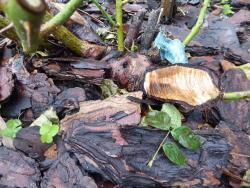It's important to distinguish the "bud union" (which is a normal swollen area at the base of the plant from which canes emerge on grafted roses), from abnormal tumorous-like growths such as crown galls (which are caused by soil-born bacteria). It would have been easier to determine if the area circled in blue was a gall before it was sliced in half, because the exterior of galls are very distinguishable by their bumpy appearance.
My advice is to Google "rose crown gall" and you will find numerous websites that describe not only crown gall, but cane gall (start with this site:
http://www.rosemagazine.com/ar...). You can use these sites to help you determine if this is what you have. Some types of galls are above ground (such as crown galls near the bud union, or cane galls higher up), while others occur below ground on the roots. Don't confuse this with the spiny galls that are caused by wasps - that's a different topic.
For galls that you can see, it's important to cut off the entire gall (if possible) along with any canes growing out of it. You can then place an antibacterial ointment such as Bacitracin on the area that has been cut, in an effort to prevent re-introduction of the bacteria into the exposed plant tissue. But this is by no means a cure, and galls may re-emerge. In the future, when pruning canes close to the soil level, apply Bacitracin to those cuts as well. Also, after cutting off a gall, it's essential to sanitize your pruners with alcohol or a diluted bleach solution afterwards, so that you don't go on to spread the disease through subsequent, normal pruning.
If a lot of your roses have galls near the base of the plant, then the bacteria may be widespread in your garden soil, so be careful not to injure the base of rose plants with things like string trimmers, lawn mowers, garden hoes, or shovels since scrapes create points of entry for the bacteria.
Depending on how and where a gall has spread, it may not impact the plant's health too much after being removed, but in other cases it can interfere with nutrient uptake if it has spread into the bud union, and can make the plant weak. It isn't a death sentence, but if my memory serves, I lost a young rose to gall many years ago.
